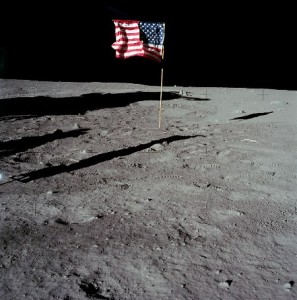Can NASA Get Its Groove Back?
Remember when space exploration was “groovy” and excitement about seeing humans explore the Solar System within our lifetimes was palpable?

Remember when space exploration was “groovy” and excitement about seeing humans explore the Solar System within our lifetimes was palpable? What happened to NASA and America’s dream to boldly go? The pathway that assured us that space exploration is cool, amazing and pushes excellence has disappeared, littered instead by U-turns and Stop signs. NASA’s groove was the right stuff. When did vanish? Can we get it back?
America’s rhythm is stalled. Movement in our economy is going the wrong way. Education standards are mediocre. We’re not evolving. We’re not in our groove. And the country feels it.
Is NASA’s dilemma symptomatic of what ails us? “If we could put a man on the Moon..” has become cliché but was the zenith of American exceptionalism. The last time a human walked on the Moon was in December 1972 – 38 years ago next month. NASA has long since stopped getting “free drinks” from the retelling of that decades old conquest. It’s time to light the fire again and do something profound, this time something cumulative and lasting. Conquering the Moon is where we found our groove and if we choose, where we can reclaim it.
NASA languished a year waiting to hear what, where and when their mission would be. They’re still waiting, as NASA ponders how to proceed on the “Flexible Path” to their ultimate goal of Mars. Congress recessed without passing a federal budget for 2011 and NASA is operating under a continuing resolution. Things are certainly flexible.
The latest buzz in the space blogosphere is about the recent midterm election results and subsequent changes in House committees with Republicans in the majority. After these new committee chairs take charge, will they set new priorities? Only time will tell but past statements by those mentioned to fill these positions give some clues. They seem less inclined to “sell the farm,” thereby giving control of U.S. space access to foreign entities. They seem to be cautious about handing the reins of LEO access to commercial start-ups, preferring to have them prove themselves first, while at the same time guaranteeing that NASA retains the infrastructure necessary to assure our national interests in space. Will their priorities for NASA rest more with the agency staying as a national economic and security asset and less as an international outreach program, heavily influenced by Earth science concerns? Much rests on the decisions made and the money appropriated by the incoming Congress.
The current administration’s decision to abandon NASA’s mission of resource utilization on the Moon needs to be revisited. The ability of the United States to routinely access cislunar space through the use of the Moon and its resources needs to be well understood and addressed. We cannot afford to remain complacent about the Moon while other countries move forward to reap the rewards of lunar return. The United States needs to make smart investments that will pay long-term dividends. Lunar return is one of those economic and technological investments.
The majority of the panel of engineers and scientists invited to speak at the recent Space Manufacturing conference meeting at NASA’s Ames Research Center (sponsored by the Space Studies Institute) held the view that lunar mining was the logical next move and that government needed to “prime the pump” and demonstrate that this was possible before private enterprise would follow. We need private sector money to fully pursue the purpose and realize the potential of space exploration. NASA needs to show that resource utilization is possible on the Moon. Once we understand how to access and develop lunar resources, private enterprise will capitalize on these findings. As the door to a sustainable space faring infrastructure finally swings open, the tyranny of the rocket equation will be broken.
It is time for America to find its groove again. It is time to extol the right stuff and pursue goals of national excellence. Setting a goal that may be obtained in 30 years is not a space program. A return to the Moon to learn how to use its resources is achievable using existing technology and within the decade-long timescales demanded by our political process.
/https://tf-cmsv2-smithsonianmag-media.s3.amazonaws.com/accounts/headshot/blog_headshot_spudis-300x300.jpg)
/https://tf-cmsv2-smithsonianmag-media.s3.amazonaws.com/accounts/headshot/blog_headshot_spudis-300x300.jpg)